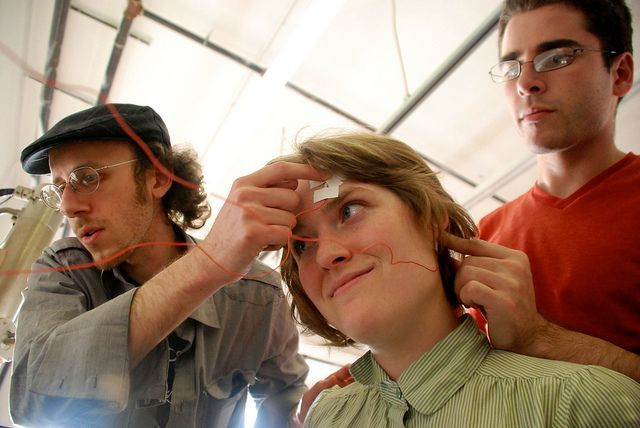Electric ‘Thinking Cap’ Sends Current Through Your Brain To Help You Learn Faster And Make Fewer Mistakes

What if math suddenly became easy for you? Or if you could finally strum the perfect D chord, without the hours of blistered fingertips in between. Science hasn’t arrived at instant knowledge acquisition yet, but with the new findings from a Vanderbilt University study, an electric “thinking cap” may move us in the right direction.
The brain’s medial-frontal cortex is the star of the researchers’ latest study. It’s here that we develop the skills for concentration, abstracting ability, personality expression, judgment, and the ability to solve problems. If somehow this area could be stimulated at will, would we become better concentrators? Better abstractors and problem solvers? That’s the question Vanderbilt scientists Robert Reinhart and Geoffrey Woodman sought to answer.
Among its many other important duties, the medial-frontal cortex regulates the time it takes for you to realize you made a mistake. People whose medial-frontal cortexes work slower tend also to be slower at correcting their errors, whether it’s in building a shed or finding the area under a curve. “We wanted to reach into your brain and causally control your inner critic,” said Reinhart, a Ph.D. candidate, in a university news release.
That “reaching in” ended up looking something like an old-fashioned tooth ache fix. Subjects wore an elastic headband around their head and chin, with sponges soaked in saline pressed against their cheeks. Inside the headband Reinhart and Woodman stuck two electrodes, which sent a steady stream of transcranial direct current stimulation (tDCS) for 20 minutes.
The technique relies on a mild current being passed through a subject’s brain via the muscles, bone, and skin on the surrounding body, and it’s also “one of the safest ways to noninvasively stimulate the brain,” according to Reinhart. Subjects typically only experience light tickling or itching on first use.
After applying the “cap,” researchers had subjects play a game that involved matching colored tiles to specific buttons on a video game controller. They were given only second to register their answers and were also asked occasionally not to respond at all. The test was designed to make their medial-frontal cortexes fire like crazy, putting the cap to the ultimate test.
There were three groups involved with the study. One group had the starting electrode (known as the anodal electrode) planted on the crown of their head. Another group had the back end of the electrode (cathodal) on their head, and the third had a sham cap that delivered no electricity but still tingled. Researchers checked to see if they could control how fast subjects auto-corrected their mistakes depending on which electrode began at the participants’ heads.
As it turned out, they were able to “up-regulate” the flow of information more quickly to subjects’ brains — in other words, make them realize they messed up faster — when the anodal electrode was placed on the crowns of their heads. “We can make you more cautious, less error-prone, more adaptable to new or changing situations—which is pretty extraordinary,” Reinhart said.
While the application is new, tDCS has been harnessed for consumer use for a number of years. Consider foc.us, an American-based company that specializes in gaming headsets that allegedly “overclock your brain” and “make your synapses fire faster.”
While the language is nice (“overclocking” is decidedly a hard computing term), Reinhart and Woodman concede their subjects didn’t notice any difference in their performance. Reaction times increased by the milliseconds and correct matches occurred four percent more often. On the EEG, however, this was significant and visible, and “far better than that observed in studies of pharmaceuticals or other types of psychological therapy,” Woodman said.
The findings are also just the beginning. Bringing the technology to other disciplines could hold great promise, the researchers contend, for patients with ADHD and schizophrenia, and other learning disorders that complicate and disrupt people’s daily lives.
Source: Reinhart R, Woodman G. Causal Control of Medial–Frontal Cortex Governs Electrophysiological and Behavioral Indices of Performance Monitoring and Learning. The Journal of Neuroscience. 2014.



























